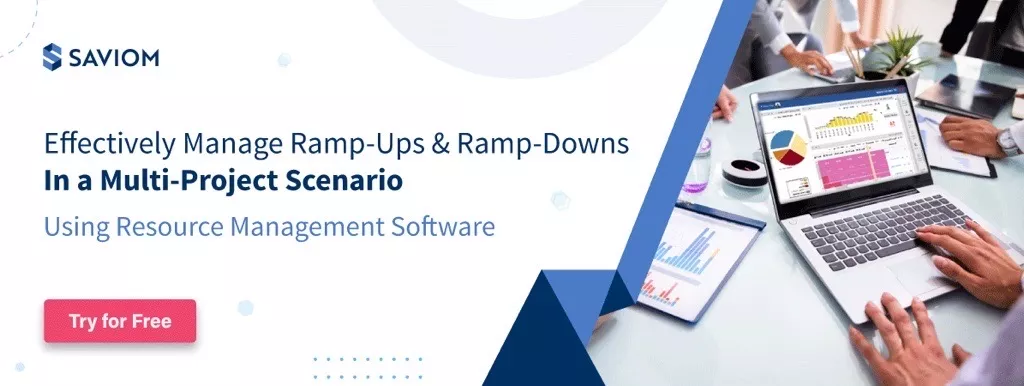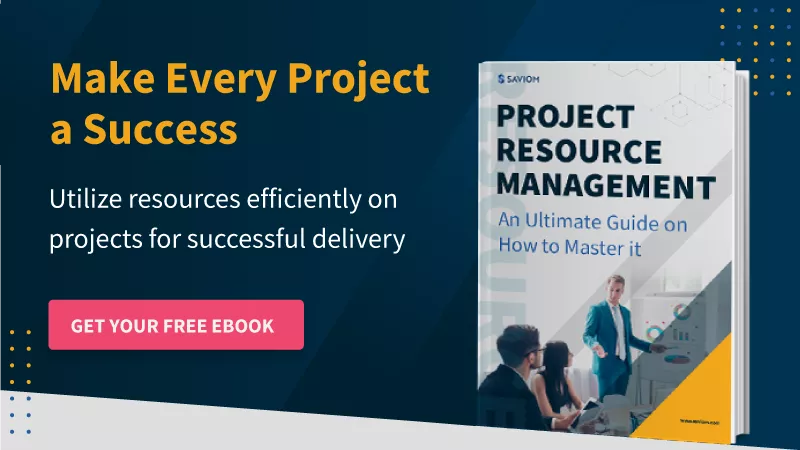While managing resources in a multi-project environment, you must have faced the challenges of handling several requirements simultaneously. Indeed, it’s a daunting task. Managers have to strategically prioritize projects, identify suitable resources, ensure a 100% or a near-perfect fill rate for every project, to stay competitive.
In fact, in a multi-project scenario, managers receive these resource requests in a staggered manner. Moreover, they are not usually forewarned of the project closure. Hence, keeping track of varying timelines (including both onset and end dates) and staying abreast of roll-offs or release of the resources makes it all the more arduous.
This inability to stay atop of all project and resource schedules results in unmanaged ramp-up and ramp-down that can negatively affect the organization’s bottom line.
Therefore, it is imperative for resource managers to formulate effective strategies to manage frequently changing resource requests. This blog discusses the negative consequences of unmanaged ramp-up and ramp-down and a few proven techniques to tackle them.
But first, let’s understand the processes in detail.
Understanding ramp-up and ramp-down
Before going into the details of these two terms, it is essential to get a brief idea of the project lifecycle.
A project’s lifecycle primarily comprises five stages as follows:
- First, initiation, involves defining deliverables, objectives, risks, and requirements, selecting the project management methods, etc.
- Planning entails documenting a project plan, creating a work breakdown structure, defining roles and responsibilities, allocating resources to tasks, scheduling, etc.
- Execution constitutes maintaining communication flow amongst the resource pool, tracking and handling change requests and dependencies, and providing extra time, budget, or resources if required.
- Control and Monitor, run in parallel with the execution phase, which comprises tracking KPIs, conducting status meetings with stakeholders and teammates, etc.
- Closure encompasses terminating the project officially, releasing resources, submitting deliverables, and documenting lessons learned.
Given the five stages of the project’s lifecycle, let’s understand how ramp-up and ramp-down occur based on various scenarios.
Read More: What is Project Lifecycle and How to Get it Right?
Case 1 – Ramp-up due to the initiation/peak time in a project
In the planning phase, when the project manager creates a work breakdown structure, they identify resource requirements and raise requests. A sudden increase in resource requirement is known as ramp up. The resource manager identifies and allocates the appropriate resources to fulfill the resource requests.
Ramp-up occurs during “execution” stage when additional resources are needed to complete different tasks. Let’s consider an IT project, for example. In its development phase, the project needs multiple resources with different skills. The resources will be required in a staggered manner within the project. Accordingly, the project manager provides a monthly resource requirement so that it gives sufficient lead time to the resource manager for fulfillment.
Case 2 – Ramp-down due to a large-scale roll-off from a project.
When a project has passed through its peak or the “execution” phase and reaches “control” or “closure,” resource requirements decrease. It requires only limited resources to handle operational activities while other team members can be released in a phased manner. At this stage, the project manager rolls off the excess resources from the project, causing a ramp-down. Apart from project closure, an abrupt halt, incorrect resource estimation, or project failure can also cause a ramp-down.
For example, after the development and final delivery of the IT project, the “maintenance” phase begins. Depending on the nature of the contract, the organization may only require certain developers to add new functionalities or testers to fix bugs, etc. Thus, the manager will release other resources from the project.
Now that the basics of ramp up and ramp down are clear, let’s understand their repercussions if not managed proactively.

Negative effects of ineffective ramp up & ramp-down management
Ramp-up and ramp-down are inherent to every project. However, if not tackled properly, it can negatively impact the organizational efficiency and resource health index.
Enlisted below are some consequences:
Increase in bench size
Due to a lack of visibility into projects and resources’ schedules, the resource manager fails to identify the projects approaching ramp-down. Consequently, resources from multiple projects hit the bench, increasing the bench size. Since people on the bench do not generate any revenue and are on the company’s payroll, it affects the bottom line.
Rise in unplanned attritions
As stated earlier, poorly managed ramp-down can increase bench size and disengage the workforce. When resources don’t have enough work and their skills are not utilized effectively, it results in disengagement, lowered morale, and reduced productivity. It may further erode the sense of purpose and belonging. Eventually, they may decide to look for better opportunities elsewhere, causing unplanned attritions.
Read More: Ten Effective Strategies to Reduce Employee Turnover
Billing losses due to unavailability of resources
Ideally, when a project manager estimates skill requirements and raises resource requests, the resource manager should fulfill them before the due date. However, if a large number of resource requirements come at the eleventh hour, they cannot be timely fulfilled, leading to billing losses.
Timeline delays & budget overruns
A lack of foresight into project demands can result in a failure to manage the sudden resource requirement effectively.
When projects don’t get the requisite resources on time, it may lead to delays in their timelines. Moreover, hiring a contingent workforce to meet the last-minute demands can compromise quality, and will also be costlier, eventually causing budget overruns.
Lost opportunities and decline in company revenue
Inability to foresee the approaching ramp-downs gives the resource manager an impression that all the resources are involved in one or the other project. As a result, when a new project arrives, they think they don’t have the visibility of resource availability. As a result, the project delivery team can refuse new work or delay its timeline, causing a loss of opportunities and a decline in company revenue.
Last-minute firefighting for resources
When resource managers fail to foresee the future or pipeline project demand or do not receive the resource requests on time, they do not get sufficient lead time to procure the right resource. Thus, this triggers the last-minute firefighting for resources which may even lead to the hiring of a mismatched skillset, further deteriorating the project quality.
Read More: How Can Resource Managers Deal with Different Resource Constraints?
It is evident that both ill-managed ramp-up and ramp-down activities can have various ramifications. Nevertheless, implementing modern resource management software can help you stay forewarned of these activities and manage them proactively.
The following section explains how.
Ways resource management software can help manage ramp-ups and ramp-downs effectively
The art of managing ramp-up and ramp-down activities across multiple projects is crucial for successful project execution and maintaining resource health index. Implementing a resource management tool along with soft skills such as quick decision-making, negotiation power, etc., will help the resource manager master this process.
Enlisted below are a few prominent ways a resource management tool can help.
Provides enterprise-wide visibility of resource and project schedules
A robust resource management software provides 360-degree visibility of resources, their schedules, other attributes such as skills, location, experience, etc. Moreover, resource managers get a comprehensive view of future projects as and when project managers create vacancies via generic booking. It helps the resource managers stay abreast of the upcoming projects and expected ramp-ups, which further assists them in taking proactive actions to fill the spot in advance.
Similarly, with an overview of current and future resource schedules, managers can foresee when they will be released from projects. Thus, they can find appropriate projects and allocate them before they hit the bench. It will help reduce the resources’ bench time between two projects, facilitating a well-managed ramp-down.
Offers foresight into future project demands
With clear visibility into pipeline projects, the resource manager can stay forewarned of future resource requirements and skill demand. They can look into the existing workforce to analyze and determine the capacity vs. demand gaps. This will help them initiate the right resourcing measures ahead of time to avoid any hassle at the eleventh hour.
For partial skill matches, proper upskilling, cross-skilling, and training measures can help close the existing gaps. In cases where the resources don’t possess the required skillsets at all, planned hiring can help recruit the right talent at the right costs. However, hiring a contingent workforce can be a better choice for projects with demands that are one-off in nature. This proactive resource planning facilitates efficient management of ramp-ups.
Read More: 4 steps to perfect your Project Pipeline Management strategy
Delivers data-driven BI reports
A resource management tool provides various reports generated using Business Intelligence in real-time. When a project manager sends resource requests or creates a vacancy, they immediately reflect in the project vacancy report. With this, the resource manager can get a complete idea of the future resource demand. Accordingly, they can start appropriate resourcing techniques to fulfill them and avert an unmanaged ramp-up.
The people-on-the-bench report, on the other hand, plays a key role in monitoring the bench size. It also helps identify resources that will hit the bench in the future. Resource managers can leverage this report to initiate training or upskilling and prepare them to take on future projects or align their competencies to fill project vacancies.
Align sales with delivery
Involving the delivery team at the early stage of the sales process is essential. When a sales opportunity attains a particular probable stage for closure, the sales team should coordinate with the delivery team. It can help determine the project’s viability and decide whether it can be accepted or not.
Accordingly, in coordination with the project manager, the resource manager can start preparing to fulfill the upcoming demand in advance. With complete visibility into the resource pool, the manager can find or hire suitable resources ahead of time. It helps achieve on-time fulfillment of resource requests and prevents last-minute hassle in managing ramp-ups.
Allows out rotation and backfill for critical projects’ demands
Sometimes a project may experience a shortage of niche expertise. Finding these people outside the organization may be arduous and time-consuming. Also, when these critical resources get rolled off, finding projects for them may again be challenging.
Resource management software maintains an enterprise-wide record of resource profiles and schedules.
Based on that, the resource manager can out rotate some resources from the projects reaching the closure or maintenance phase. Then, they can fill the vacant positions with suitable backfills. This way, they can handle the ramp-up efficiently.
Takeaway
Rise and fall in resource demands across multiple projects are inevitable. What matters more is how efficiently you can combat them and keep all the ongoing and future projects optimally staffed with appropriate resources.
It is where handling both ramp-up and ramp-down efficiently plays a pivotal role. By combining your management and soft skills with robust resource management software, you can streamline resource planning and stay on top of them.
The Glossary
Read More: Glossary of Resource Workforce Planning, Scheduling and Management
The SAVIOM Solution
SAVIOM is the market leader in helping multinational clients manage their resources efficiently and effectively. With over 20 years of experience, this Australian-based MNC has a global presence across 50 countries and has helped 100+ clients with their Workforce Planning Software. Saviom also provides tools for Enterprise Project Resource Management, Project Portfolio Management, and Professional Service Automation. Boost your remote team collaboration with Saviom.












